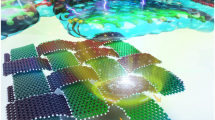Abstract
Styrene has the characteristics of low viscosity, low shrinkage, and excellent adhesion to a variety of polymer materials and is a good candidate for healing agents. In this work, styrene and benzoyl peroxide (BPO) are coated, respectively, by in situ polymerization using poly(urea-melamine-formaldehyde) as shell materials to prepare two microcapsules for self-healing materials. IR, SEM, TGA, and DTA characterize the morphology, structure, composition, and thermal properties of the microcapsules. The optimized reaction parameters of the BPO microcapsule are as follows: the combination ratio of emulsifier DBS and GA is 2:1 (0.2% + 0.1%). The pH value of in situ polymerization is 3, the stirring speed is 700 r/min, and the core-shell ratio is 1:1. The content of the two microcapsule cores can reach more than 80%. In addition, the fracture toughness and healing efficiency of the double-microcapsules epoxy self-healing composites containing 2.5, 5, 7.5, 10, and 12.5 wt% of styrene and BPO microcapsules are measured using a tapered double cantilever beam (TDCB) specimen. The weight ratio of the two microcapsules in all self-healing epoxy composites was 1:1. The results show that the healing efficiency reached 37.3% when the content of the two microcapsules was 12.5 wt% at room temperature after 24 h healing. DTA results also indicate that this system has good potential for spontaneous self-healing performance at room temperature.

















Similar content being viewed by others

References
White, SR, et al. “Autonomic Healing of Polymer Composites.” Nature, 409 (2) 794–797 (2001)
Blaiszik, BJ, et al. “Self-Healing Polymers and Composites.” Ann. Rev. Mater. Res., 40 (2) 179–211 (2010)
Yuan, YC, Yin, T, Rong, MZ, Zhang, MQ, “Self Healing in Polymers and Polymer Composites Concepts, Realization and Outlook: A Review.” Exp. Polym. Lett., 2 (4) 238–250 (2008)
Wei, H, et al. “Advanced Micro/Nanocapsules for Self-Healing Smart Anticorrosion Coatings.” J. Mater. Chem. A, 3 (2) 469–480 (2015)
Poornima, VP, Mariam, AS, Al-Maadeed, A, “TiO2 Nanotubes and Mesoporous Silica as Containers in Self-Healing Epoxy Coatings.” Sci. Rep., 6 (1) 38812 (2016)
Gamstedt, EK, Talrega, R, “Fatigue Damage Mechanisms in Unidirectional Carbon-Fibre-Reinforced Plastics.” J. Mater. Sci., 34 (11) 2535–2546 (1999)
Dong, YW, Sam, M, David, S, “Self-Healing Polymeric Materials: A Review of Recent Developments Progress.” Prog. Polym. Sci., 33 479–522 (2008)
Dry, CM, “Self-Repairing of Composites.” Proc. SPIE - The Int. Soc. Opt. Eng., 5055 376–379 (2003)
Brown, EN, White, SR, Sottos, NR, “Retardation and Repair of Fatigue Cracks in a Microcapsule Toughened Epoxy Composite – Part I: Manual Infiltration.” Compos. Sci. Technol., 65 (7) 2466–2473 (2005)
Jud, K, Kausch, HH, Williams, JG, “Fracture Mechanics Studies of Crack Healing and Welding of Polymers.” J. Mater. Sci., 16 (1) 204–210 (1981)
Park, JH, Braun, PV, “Coaxial Electrospinning of Self-Healing Coatings.” Adv. Mater., 22 (4) 496–499 (2010)
Whelehan, M, Marison, IW, “Microencapsulation Using Vibrating Technology.” J. Microencapsul., 28 (8) 669–688 (2011)
Rabanel, JM, Banquy, X, Zouaoui, H, Mokhtar, M, Hildgen, P, “Progress Technology in Microencapsulation Methods for Cell Therapy.” Biotechnol. Progr., 25 (4) 946–963 (2009)
Dubey, R, Shami, TC, Rao, K, “Microencapsulation Technology and Applications.” Def. Sci. J., 59 (1) 82–95 (2009)
Brown, EN, Kessl, MR, White, SR, “In Situ Poly(urea-formaldehyde) Microencapsulation of Dicyclopentadiene.” J. Microencapsul., 20 (6) 719–730 (2003)
Lang, S, Zhou, Q, “Synthesis and Characterization of Poly(urea-formaldehyde) Microcapsules Containing Linseed Oil for Self-Healing Coating Development.” Prog. Org. Coat., 105 99–110 (2017)
Wang, HR, Zhou, QX, “Evaluation and Failure Analysis of Linseed Oil Encapsulated Self-Healing Anticorrosive Coating.” Prog. Org. Coat., 118 108–115 (2018)
Ebrahiminiya, A, Khorram, M, Hassanajili, S, Javidi, M, “Modeling and Optimization of the Parameters Affecting the In-Situ Microencapsulation Process for Producing Epoxy-Based Self-Healing Anti-Corrosion Coatings.” Particuology, 36 59–69 (2018)
Tong, XM, Zhang, T, Yang, MZ, Zhang, Q, “Preparation and Characterization of Novel Melamine Modified Poly(urea–formaldehyde) Self-Repairing Microcapsules.” Coll. Surf. A Physicochem. Eng. Aspects, 371 (1–3) 91–97 (2010)
Li, Y, Liang, GZ, Xie, JQ, Guo, J, Li, L, “Thermal Stability of Microencapsulated Epoxy Resins with Poly(urea–formaldehyde).” Polym. Degr. Stab., 91 (10) 2300–2306 (2006)
Hu, J, Xia, Z, Situ, Y, Chen, H, “Mechanical Properties of Microcapsules Encapsulating DCPD with MF.” Ciesc J., 61 2738 (2010)
Yuan, L, Liang, GZ, Xie, JQ, Lan, L, Guo, J, “The Permeability and Stability of Microencapsulated Epoxy Resins.” J. Mater. Sci., 42 4390–4397 (2007)
Asadi, AK, Ebrahimi, M, Mohseni, M, “Preparation and Characterisation of Melamine-Urea-Formaldehyde Microcapsules Containing Linseed Oil in the Presence of Polyvinylpyrrolidone as Emulsifier.” Pigm. Resin Technol., 46 (4) 318–326 (2017)
Guo, WJ, Zheng, BZ, Yuan, QM, “Preparation of Poly(urea Melamine and Formaldehyde Composite Resin) Walled Microcapsules Containing Styrene.” J. Funct. Mater., 43 (7) 892–895 (2012)
Brown, EN, White, N, “Fracture Testing of a Self-Healing Polymer Composite.” Exp. Mech., 42 372–379 (2002)
Guadagno, L, et al. “Self-Healing Epoxy Nanocomposites via Reversible Hydrogen Bonding.” Compos. Part B: Eng., 157 1–13 (2019)
Ahangaran, F, Hayaty, M, Navarchian, AH, Pei, Y, Picchioni, F, “Development of Self-Healing Epoxy Composites via Incorporation of Microencapsulated Epoxy and Mercaptan in Poly(methyl methacrylate) Shell.” Polym. Test., 73 395–403 (2018)
Acknowledgments
The authors disclosed receipt of the following financial support for the research, authorship, and publication of this article: This work was supported by the National Natural Science Foundation of China (No.21502166).
Author information
Authors and Affiliations
Corresponding author
Additional information
Publisher's Note
Springer Nature remains neutral with regard to jurisdictional claims in published maps and institutional affiliations.
Rights and permissions
About this article
Cite this article
Li, Z., Chen, H., Xu, Q. et al. Styrene and BPO poly (urea-melamine-formaldehyde) microcapsules prepared via in situ polymerization to promote the self-healing properties of epoxy composites. J Coat Technol Res 19, 1837–1850 (2022). https://doi.org/10.1007/s11998-022-00655-5
Received:
Revised:
Accepted:
Published:
Issue Date:
DOI: https://doi.org/10.1007/s11998-022-00655-5



